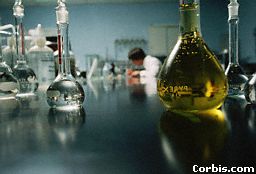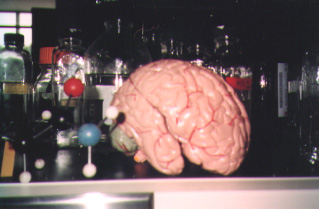|
PART1: CHEMICAL EFFECTS ON INTERPERSONAL RELATIONS: |
|
|
SIMULATING “THE URGE TO LOVE" |
|
|
Part 1: Section 3 |
|
|
Pheromones in Humans: Menstrual Cycle Synchronization |
|
| As I mentioned in the last section, there is good evidence for the existence of the vomeronasal organ (VNO) in various animals such as rodents. This organ has been linked to the detection of pheromones. There is a great debate as to whether humans have a VNO. Some anatomists believe they found pits inside our nostrils that might be the VNO, although it might not be functional. Currently there is no solid evidence for the existence of VNO in humans. However, this does not mean that there may not be other chemosensory pathways involved in the detection of air borne chemicals. Some of the best evidence for the possible existence of pheromones in humans comes from the studies of menstrual cycle synchronization. | |
|
After some time of living with my college roommate, I noticed that our complaining due to menstrual cramps came about the same time or within a week of each other. Actually, by the end of the year we could predict when the other would get her period more or less within couple of days of the other. I witnessed the same phenomenon when I lived on a hall group. Though I lived alone, it was obvious that my menstrual cycle usually moved towards other women on my hall and eventually synchronized with theirs. |
|
| In 1970, Martha McClintock, a junior at Wellesley, noticed the same pattern amongst her dorm mates and did a senior thesis on this topic. Her study wound up being the first published work that was pretty much an acknowledgment of the fact that women who live together or spend a lot of time with each other have converging menstrual cycles. She postulated that pheromones released from the women’s skin glands into the environment were the catalysts of the observed synchronization. That is, women’s unique chemicals affected the physiology of others. | |
| In 1988, as a professor of biopsychology at the University of Chicago, McClintock and Kathleen Stern performed further studies in support of the original hypothesis. The researchers determined that compounds taken from underarm secretions of women in the early phase of the menstrual cycle could significantly shorten the cycle of women exposed to these extract. On the other hand, if the compounds are extracted at the mid cycle or during ovulation, the extracts have the opposite effect. So to what extent can we say that pheromones exist and influence the behavior of humans? | |
| The way I want to approach the answer is through a brief examination of the relationship between observation and theory. For instance, we all believe in the concept of energy. However, the truth is that none of us actually seen energy. The reason this theory is so prevalent is because there is an overwhelming amount of observations that can be explained through the existence of energy. For instance, if we define energy as the ability to do work, we can say that a ball on top of the table has gravitational potential energy. It possesses it on the virtue of what we defined the concept to be; if the ball falls it can do work on, say, a string by compressing it. | |
|
The point here is that scientific theories are a well-defined
set of concepts though which we explain our observations. If there are
enough observations that fit that concept, we make it a theory. Keeping
this in mind I want to turn to evaluating the human pheromone hypothesis. |
|
| Although researchers doing work in the area have not yet isolated actual human pheromones, there exist enough observational phenomena which can be accounted for by the concept of such air borne chemicals. The evidence for pheromones in rats is very strong and in some cases the actual pheromones were extracted and characterized. To my surprise, my advisor, Dr. Grobstein, once noted: “What makes you think we are that different from rats?” That is, there is no reason to think that the pheromone phenomenon observed in rodents cannot be extended to humans. However, it should be kept in mind that humans are unlikely to be as strictly beholden to pheromone influence on behaviors such as mating. A female ovulating boar when exposed to a male boar’s saliva immediately goes into a spread legged mating postures. Human behavior is just not that clear cut! | |
|
Photo by Rachel Berman |
|
| The real significance of pheromones as applied to the broader picture of my research is that | |
|
PHEROMONES DO NOT GENERATE CONSCIOUS SENSATION |
|
|
As is evidenced, there is reason to think that women synchronize their menstrual cycles through some sort of pheromone ques. Thus, it is not so farfetched to say that pheromone ques may have an influence in human attraction and to some degree account for what we call “falling in love, ” at least the part of the phenomenon that seems to occur “without reason.” However, one must keep in mind that convergence of menstrual cycle may or may not occur in some cases. As for the extension of the analogy, pheromones may or may not come into play when one experiences the feeling associated with love. Although chemicals affect behavior, there is much more to the story which I will examine in Part 2 . |
|
|
LINKS ON PHEROMONES |
|
|
Pheromones in
Humans: Myth or Reality Pheromones: Potential
participants in your sex life Human Pheromones
and Synchronization of Menstrual Cycles Debate over the
concept of human pheromone Paper on Synchronized
Cycles Human Pheromones
and the Neuroendocrinology of Behavior Pheromones in Insect and Human Pheromones
http://www.ultranet.com/~jkimball/BiologyPages/P/Pheromones.html#human
Health Report on
Menstrual Synchrony Converging Menstrual
Cycles |
|

